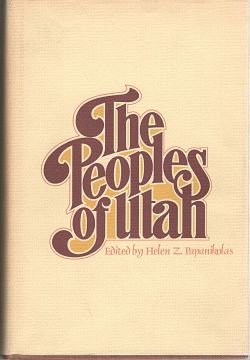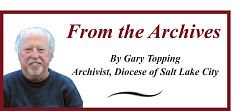Bicentennial brought forward Utah's Catholic history
Friday, Jul. 15, 2016

Courtesy photo
Photo 1 of 2
"The Peoples of Utah," which was published in 1976, tells the history of some of the ethnic groups that migrated to Utah, including predominantly Catholic groups such as Hispanics and Italians.
The year 2016 is the 35th anniversary of the Bicentennial Year 1976, which was a great year of celebration, commemorating first of all the signing of the Declaration of Independence, which all Americans, including Utahns, commemorated. For us Utah Catholics, 1976 also was the bicentennial of the Dominguez-Escalante expedition, which we celebrated by sending out teams of researchers to retrace and mark significant points on the friars’ route, and by publishing a fresh new translation of their diary. Finally, we had a huge Mass in the Salt Palace celebrated by Bishop Joseph L. Federal.
That year also saw publication by the Utah State Historical Society of “The Peoples of Utah,” an anthology of articles by various authors on the history of Utah’s ethnic groups, edited by Helen Z. Papanikolas.
I was in graduate school at the University of Utah at the time, and I was proud to note that four of the articles were written by my fellow graduate students: Ron Coleman on African-Americans, Phil Notarianni on Italians, Joe Stipanovich on Yugoslavs, and Vicente Mayer on Hispanics.
I’ve never written ethnic history, but I was well aware that I was holding a revolution in my hands when I purchased my copy. No longer would Utah history be just a story of Mormon pioneers and their hardships in crossing the plains and settling a desert – important as that story is. Henceforth, Utah history would be the story of all of us, no matter how humble or marginalized, no matter our social status, ethnicity or religion.
For me, a large part of the book’s importance was that most of the people whose stories it recounted were humble laborers, working-class people, from a similar background to my own. Despite whatever obstacles our different ethnicities may have presented, I understood them. I never had to endure immigration or prejudice or cope with a language barrier, but in large part, their story was my story.
Only Helen Papanikolas could have pulled together such a collection authored by people of vastly different training and skills in research and writing. Getting everyone into the harness and keeping them moving forward together was an immense task, but she had the gentle yet firm touch that could provide prodding or handholding as required. Herself a daughter of Greek immigrants, she had already distinguished herself by bringing the Greek experience under the light of historical scrutiny, and was one of only two people in the history of the “Utah Historical Quarterly” to have been given an entire issue. Her “Toil and Rage in a New Land: The Greek Immigrants” in Utah in the Spring 1970 number was a groundbreaking venture.
Of course “The Peoples of Utah” provided a great boost to the writing of Utah Catholic history, because some of the groups – the Italians, the Hispanics and some of the Yugoslavs – were predominantly Catholic.
I did not know my great archival predecessor at the time, but Bernice Mooney no doubt rode the wave of this movement to create her “Story of the Cathedral of the Madeleine” (1980) and “Salt of the Earth” (1987). Those two great books opened the door for the rest of us who have added to the growing literature on Utah Catholic history, most recently and impressively Deacon Armando Solorzano’s “Recuerdo, Celebracion y Esperanza: We Remember, We Celebrate, We Believe, Latinos in Utah” (2014), which contains a grateful acknowledgment of Vince Mayer’s pioneering work.
So my assignment for you in 2016 is to find a copy of “The Peoples of Utah,” buy it and read it, and join the revolution. It’s still going on.
For questions, comments or to report inaccuracies on the website, please CLICK HERE.
© Copyright 2024 The Diocese of Salt Lake City. All rights reserved.
© Copyright 2024 The Diocese of Salt Lake City. All rights reserved.


Stay Connected With Us